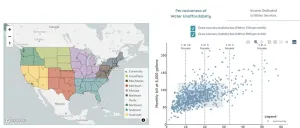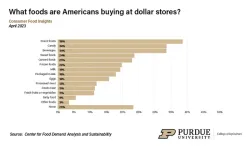(Press-News.org) The catastrophic Australian bushfires in 2019-2020 contributed to ocean cooling thousands of miles away, ultimately nudging the Tropical Pacific into a rare multi-year La Niña event that dissipated only recently.
The research was led by the National Center for Atmospheric Research (NCAR) and in Science Advances.
La Niña events tend to impact the winter climate over North America, causing drier and warmer than average conditions in the southwest U.S., wetter weather in the Pacific Northwest, and colder temperatures in Canada and the northern U.S. Because the emergence of La Niña can often be predicted months in advance, it’s an important phenomenon for seasonal climate forecasts.
“Many people quickly forgot about the Australian fires, especially as the COVID pandemic exploded, but the Earth system has a long memory, and the impacts of the fires lingered for years,” said NCAR scientist John Fasullo, lead author of the study.
The research was funded by the U.S. National Science Foundation, which is NCAR’s sponsor, NASA, and the U.S. Department of Energy.
A rare La Niña three-peat
La Niñas are not uncommon, but an occurrence for three consecutive winters is rare. The recent run of La Niñas, beginning in the winter of 2020-21 and continuing through last winter, is only the third string of three in the historical record, which dates back to 1950.
The recent La Niña streak is also unusual because it is the only one that did not follow a strong El Niño — a warming instead of cooling in the Tropical Pacific with similar but opposite climate impacts.
Scientists have previously established that events in the Earth system, including large volcanic eruptions in the Southern Hemisphere, can shift the odds toward a La Niña emerging. In the case of a volcano, emissions spewed high into the atmosphere can result in the formation of light-reflecting particles called aerosols, which can cool the climate and ultimately create favorable conditions for La Niña.
Given the massive scale of the Australian fires — which burned an estimated 46 million acres — Fasullo and his co-authors wondered what climate impacts the resulting emissions might have had.
To investigate the question, the researchers used an advanced NCAR-based computer model called the Community Earth System Model, version 2, to run two batches of simulations on the Cheyenne system at the NCAR-Wyoming Supercomputing Center. All the simulations started in August of 2019, before the blazes in Australia became historically large, but only one set incorporated the emissions from the wildfires as observed by satellite. The other used average wildfire emissions, the normal practice when running long-term climate model simulations.
The research team found that the emissions from the wildfires, which quickly encircled the Southern Hemisphere, kicked off a chain of climate interactions. Unlike a volcanic eruption, the bulk of wildfire emissions did not make it high enough in the atmosphere to cool the climate by directly reflecting sunlight. Instead, the aerosols that formed from the emissions brightened the cloud decks across the Southern Hemisphere and especially off the coast of Peru, which cooled and dried the air in the region, ultimately shifting the zone where the northern and southern trade winds come together. The net result was a cooling of the Tropical Pacific ocean, where La Niñas form, over multiple years.
“It’s a Rube Goldberg of climate interactions that we were only able to identify because our model now represents specific details in the evolution of smoke and cloud-aerosol interactions, a recent improvement to its capabilities,” Fasullo said.
Improving the forecast
In June 2020 — just a few months before the first of the three La Niñas formed — some seasonal forecasts were still predicting “neutral” conditions in the Tropical Pacific, meaning that neither a La Niña nor El Niño was favored. Instead, a strong three-year La Niña materialized.
Fasullo said the new research helps explain this missed forecast and highlights the importance of using a coupled Earth system model, which includes the atmosphere and the ocean, as a forecast tool.
The research also underscores the importance of having realistic wildfire emissions, both in seasonal climate predictions and long-range climate projections. Currently, biomass burning emissions in most climate model simulations are prescribed, meaning they are imposed on the model run and not determined by interactions happening within the model. For example, a simulated hot and dry period in the model simulation would not lead to more wildfires, and therefore more emissions within the simulation.
“As the climate changes, the emissions from wildfires will also change,” Fasullo said. “But we don’t have that feedback in the model. It is the goal of our current work to incorporate these effects as realistically as possible.”
This material is based upon work supported by the National Center for Atmospheric Research, a major facility sponsored by the National Science Foundation and managed by the University Corporation for Atmospheric Research. Any opinions, findings and conclusions or recommendations expressed in this material do not necessarily reflect the views of the National Science Foundation.
END
Australian bushfires likely contributed to multiyear La Niña
New study finds string of climate impacts related to wildfire emissions
2023-05-10
ELSE PRESS RELEASES FROM THIS DATE:
Deployable electrodes for minimally invasive craniosurgery
2023-05-10
Stephanie Lacour’s specialty is the development of flexible electrodes that adapt to a moving body, providing more reliable connections with the nervous system. Her work is inherently interdisciplinary.
So when a neurosurgeon asked Lacour and her team to come up with minimally invasive electrodes for inserting through a human skull, they came up with an elegant solution that takes full advantage of their expertise in compliant electrodes, and inspired by soft robotics actuation. The results are published in Science Robotics.
The challenge? To insert a large cortical electrode array through a small hole in the skull, deploying the device in a space that measures about ...
Study: AI models fail to reproduce human judgements about rule violations
2023-05-10
In an effort to improve fairness or reduce backlogs, machine-learning models are sometimes designed to mimic human decision making, such as deciding whether social media posts violate toxic content policies.
But researchers from MIT and elsewhere have found that these models often do not replicate human decisions about rule violations. If models are not trained with the right data, they are likely to make different, often harsher judgements than humans would.
In this case, the “right” data are those that have been labeled by humans who were explicitly asked whether items defy a certain rule. Training involves showing a machine-learning ...
Built to outlast: Body type may give athletes upper hand in certain climates
2023-05-10
Triathlons such as Ironman and Norway's Norseman competition epitomize human endurance with competitors undertaking nearly 150 miles of running, swimming and biking in grueling conditions.
But behind the training and resilience may be basic rules of ecology that help determine the victor long before contestants leave the starting line, according to research from Dartmouth.
An analysis of nearly 200 Ironman contestants over two decades suggests that performance — specifically in the marathon portion of the event — is linked to how an athlete’s physique is adapted to shedding or retaining heat in certain climates.
Published in the journal PLOS ...
Coping Under COVID: Study provides lessons from the pandemic on how to cope with large-scale traumatic events
2023-05-10
A new study in the journal PLOS ONE examines how individuals coped with stressors during the COVID-19 pandemic and which strategies were associated with higher quality of life.
The study’s findings provide important insights for both individuals and institutions as they prepare for and respond to future large-scale traumatic events. It was based on responses from more than 1,000 Americans on their experiences and behaviors during the pandemic.
The research found that problem-focused and emotion-focused coping strategies were associated with higher quality of life, while avoidant coping had a negative correlation.
Problem-focused coping involves ...
MD Anderson research highlights for May 10, 2023
2023-05-10
HOUSTON ― The University of Texas MD Anderson Cancer Center’s Research Highlights showcases the latest breakthroughs in cancer care, research and prevention. These advances are made possible through seamless collaboration between MD Anderson’s world-leading clinicians and scientists, bringing discoveries from the lab to the clinic and back.
Recent developments include a combination therapy for acute lymphoblastic leukemia, new insights into the evolution of anaplastic thyroid cancer, a promising new treatment approach for PTEN/p53-deficient pancreatic cancer, a novel pan-species artificial intelligence model to detect cancer cells, a ...
Millions of U.S. households may struggle to afford basic water services
2023-05-10
A new analysis suggests that about one in seven households across the U.S. may face financial hardship in paying for access to water and wastewater services. Lauren Patterson and colleagues at Duke University, North Carolina, present these findings in the open-access journal PLOS Water.
U.S. households pay utilities for access to water for drinking, cooking, cleaning, and sanitation, as well as for wastewater services. However, in recent years, the cost of these services has increased alongside a widening income gap, fueling affordability concerns. ...
Data from Argonne’s Advanced Photon Source provides foundation for first US approved RSV vaccine
2023-05-10
Respiratory syncytial virus (RSV) is a highly contagious disease that affects millions of people each year around the world, resulting in an estimated 160,000 deaths. In the United States, severe RSV causes 6,000 to 10,000 deaths among people 65 years of age or older.
On May 3, the U.S. Food and Drug Administration approved Arexvy, an RSV vaccine developed by pharmaceutical company GSK plc, formerly GlaxoSmithKline plc. It is the first RSV vaccine to be approved in the United States, and according to GSK’s press release, the first for older adults to be approved anywhere in the world. This is a ...
New procedure allows micro-printing inside existing materials with greater accuracy
2023-05-10
3D printers form objects by layering melted plastic or metal, but this only works on large scales. What you need to fabricate microdevices for which the layering step is not feasible? What if it were possible to print directly into the bulk of an existing three-dimensional material?
The research groups of Lynford Goddard and Paul Braun, professors at the University of Illinois Urbana-Champaign, have been collaborating to develop such a process. They use the technique of multiphoton lithography to print inside an existing ...
Purdue April Consumer Food Insights report explores role of dollar stores in food landscape
2023-05-10
Purdue April Consumer Food Insights report explores role of dollar stores in food landscape
A market for an expanded grocery selection at dollar stores potentially exists, especially with consumers who live less than 10 minutes away, according to data reported in the April Consumer Food Insights report.
The survey-based report out of Purdue University’s Center for Food Demand Analysis and Sustainability assesses food spending, consumer satisfaction and values, support of agricultural and food policies, and trust in information sources. Purdue experts conducted and evaluated ...
Using reflections to see the world from new points of view
2023-05-10
As a car travels along a narrow city street, reflections off the glossy paint or side mirrors of parked vehicles can help the driver glimpse things that would otherwise be hidden from view, like a child playing on the sidewalk behind the parked cars.
Drawing on this idea, researchers from MIT and Rice University have created a computer vision technique that leverages reflections to image the world. Their method uses reflections to turn glossy objects into “cameras,” enabling a user to see the world as if they were looking through the “lenses” of everyday objects like a ceramic coffee mug or a metallic ...
LAST 30 PRESS RELEASES:
Pusan National University researchers discover faster, smarter heat treatment for lightweight magnesium metals
China’s 2024 Gastroenterology Report: marked progress in endoscopy quality and disease management
Pusan National University researchers uncover scalable method for ultrahigh-resolution quantum dot displays
Researchers use robotics to find potential new antibiotic among hundreds of metal complexes
Gut bacteria changes at the earliest stages of inflammatory bowel disease
Scientists develop new way to “listen in” on the brain’s hidden language
Brain research: “Pulse generators” grow and shrink as memories are formed
For teens, any cannabis use may have impact on emotional health, academic performance
School meals could unlock major gains for human and planetary health
Menopause hormone therapy does not appear to impact dementia risk
Signature patterns of brain activity may help predict recovery from traumatic brain injury
Dresden study uncovers new key mechanism in cancer cells
New species are now being discovered faster than ever before, study suggests
Cannabis-based products show limited short-term benefit for chronic pain, with increased risk of adverse effects
Cannabis products with more THC slightly reduce pain but cause more side effects
Clearing the brain of aging cells could aid epilepsy and reduce seizures
Brain injuries linked with potential risk of suicide, new study finds
New technique lights up where drugs go in the body, cell by cell
New study finds movement of fishing fleets can reveal shifts in marine ecosystems
Embargoed: New evidence points to potential treatment for vascular dementia
Study uncovers disrupted brain balance in alcohol dependence
Working in groups can help Republicans and Democrats agree on controversial content moderation online
Structural findings reveal how distinct GPCR ligands create different levels of activation
Anything-goes “anyons” may be at the root of surprising quantum experiments
UC review: Maximizing workplace opportunity for veterans
From generation to complex control: Metasurfaces make perfect vortex beams "within reach"
Thin-film lithium niobate-based detector: recent advances and perspectives
Exploring why some people may tend to persistently make bad choices
How cells balance their protein levels
Nirsevimab vs RSVpreF vaccine for RSV–related hospitalization in newborns
[Press-News.org] Australian bushfires likely contributed to multiyear La NiñaNew study finds string of climate impacts related to wildfire emissions





